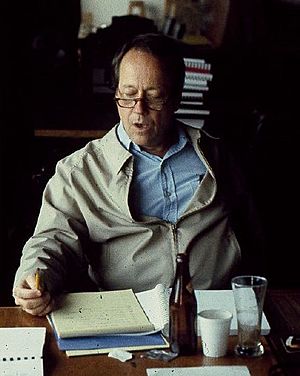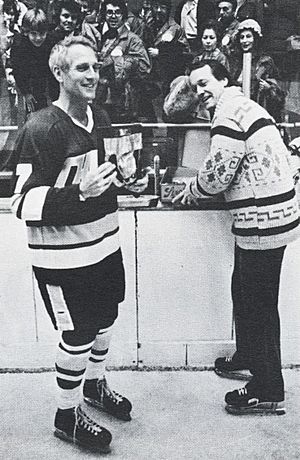George Roy Hill facts for kids
Quick facts for kids
George Roy Hill
|
|
|---|---|

Hill working on a script in 1978
|
|
| Born | December 20, 1921 Minneapolis, Minnesota, U.S.
|
| Died | December 27, 2002 (aged 81) New York City, U.S.
|
| Alma mater | Yale University |
| Occupation | Film and stage director, actor |
| Spouse(s) |
Louisa Horton
(m. 1951; div. 1971) |
| Children | 4 |
| Relatives | Tim Hill (nephew) |
George Roy Hill (December 20, 1921 – December 27, 2002) was a famous American film director. He is best known for directing popular movies like Butch Cassidy and the Sundance Kid (1969) and The Sting (1973). Both of these films starred the well-known actors Paul Newman and Robert Redford.
Hill also directed other notable films. These include The World of Henry Orient (1964), Hawaii (1966), and Thoroughly Modern Millie (1967). Later, he directed Slaughterhouse-Five (1972), The Great Waldo Pepper (1975), and Slap Shot (1977). His final film was Funny Farm (1988).
Contents
Early Life and Education
George Roy Hill was born in Minneapolis, Minnesota. His family was well-off and owned the Minneapolis Tribune newspaper. He went to The Blake School, a respected private school. Later, he attended Yale University, graduating in 1943.
A Love for Flying
From a young age, Hill loved airplanes and flying. He enjoyed visiting the airport and memorizing facts about World War I pilots. He especially admired a pilot named Speed Holman. Hill got his pilot's license when he was just sixteen years old. Airplanes often appeared in his movies, sometimes even crashing. This shows how much pilots like Speed Holman influenced him.
Music Studies at Yale
Hill also loved classical music, especially Bach. At Yale University, he studied music with a famous composer named Paul Hindemith. His film The World of Henry Orient even has a funny scene that makes a playful reference to Hindemith. While at Yale, Hill was part of several groups, including singing groups like The Spizzwinks(?) and The Whiffenpoofs.
Military Service and Early Career
During World War II, Hill served in the United States Marine Corps. He was a transport pilot in the South Pacific. When the Korean War started, he was called back to duty for 18 months. He served as a night fighter pilot and reached the rank of major.
Becoming an Actor
After his military service, Hill worked as a newspaper reporter in Texas. Then, he used the GI Bill to study at Trinity College, Dublin. He became interested in the Irish theater and started acting.
When he returned to the U.S., Hill continued to study acting in New York City. He performed in plays both Off Broadway and on Broadway. In 1952, he had a supporting role in the Hollywood movie Walk East on Beacon. He also appeared in several television shows.
Directing for TV and Stage
Hill used his experiences from the Korean War to write a TV drama called "My Brother's Keeper." He even acted in it himself. After this, he joined the Kraft Television Theater as a writer. He later began directing episodes for various TV shows.
In 1957, Hill directed the Broadway play Look Homeward, Angel. This play won a Pulitzer Prize and was very successful, running for 564 performances. He continued to direct many well-known TV episodes, including "A Night to Remember" about the sinking of the RMS Titanic. His work on "Night" earned him two Emmy nominations for writing and directing. He also directed famous episodes of Playhouse 90.
Feature Films

Hill's success in theater led him to direct his first feature film, Period of Adjustment (1962). This movie, starring Jane Fonda, was a hit at the box office. His next film was Toys in the Attic (1963).
His next project was The World of Henry Orient (1964). Critics loved the movie, but it did not make much money. Hill then directed the big movie Hawaii (1966), which was a huge commercial success. He followed this with the musical Thoroughly Modern Millie (1967).
Blockbuster Success
Hill achieved massive success with Butch Cassidy and the Sundance Kid (1969). This film starred Paul Newman and Robert Redford. It received seven Academy Award nominations and won four, including Best Song. Hill once said that his films often explored the idea of innocence versus evil.
He reunited with Newman and Redford for The Sting (1973). This movie won seven Academy Awards, including Best Picture and Best Director. For a time, Hill was the only director in history to have made two of the top 10 highest-earning films. Hill was known for disliking tardiness on set. Paul Newman joked that if you weren't on time, Hill would take you up in his airplane to "scare the bejesus out of us."
Later Career and Teaching
The Great Waldo Pepper (1975) was based on a story by Hill and starred Robert Redford. However, this film did not do well at the box office.
In 1974, Hill signed a special five-year contract with Universal Studios. A studio executive said, "He's the complete filmmaker." Hill then directed Slap Shot (1977), a popular sports comedy with Paul Newman. His later films included A Little Romance (1979) and The World According to Garp (1982), which featured Robin Williams. He also directed The Little Drummer Girl (1984) with Diane Keaton.
His last film was Funny Farm (1988), starring Chevy Chase. The screenwriter, Jeffrey Boam, noted that Hill wanted to make a more refined version of the movie. This was different from the rougher comedy Chevy Chase's fans might have expected. In his later years, George Roy Hill taught drama at Yale University.
Academy Awards and Nominations
- 1974 – Won – Best Director – The Sting
- 1970 – Nominated Best Director – Butch Cassidy and the Sundance Kid
Filmography
Director
| Year | Film | Oscar Nominations | Oscar Wins | BAFTA Nominations | BAFTA Wins | Golden Globe Nominations | Golden Globe Wins |
|---|---|---|---|---|---|---|---|
| 1962 | Period of Adjustment | 1 | 2 | ||||
| 1963 | Toys in the Attic | 1 | 2 | ||||
| 1964 | The World of Henry Orient | 1 | |||||
| 1966 | Hawaii | 7 | 3 | 2 | |||
| 1967 | Thoroughly Modern Millie | 7 | 1 | 5 | 1 | ||
| 1969 | Butch Cassidy and the Sundance Kid | 7 | 4 | 10 | 9 | 4 | 1 |
| 1972 | Slaughterhouse-Five | 1 | |||||
| 1973 | The Sting | 10 | 7 | 1 | |||
| 1975 | The Great Waldo Pepper | ||||||
| 1977 | Slap Shot | ||||||
| 1979 | A Little Romance | 2 | 1 | 2 | |||
| 1982 | The World According to Garp | 2 | |||||
| 1984 | The Little Drummer Girl | ||||||
| 1988 | Funny Farm | ||||||
| Total | 37 | 13 | 10 | 9 | 21 | 4 |
Producer
- The Great Waldo Pepper (1975)
- The World According to Garp (1982)
Writer
- The Great Waldo Pepper (1975): Story
- A Little Romance (1979): Dialogue (uncredited)
Actor
- Walk East on Beacon! (1952): Nicholas Wilben
- The World According to Garp (1982): Pilot (uncredited)
Personal Life and Death
George Roy Hill married Louisa Horton on April 7, 1951. They later divorced. Hill had four children: two sons, George Roy Hill III and John Hill, and two daughters. He also had 12 grandchildren.
After returning to civilian life for the second time, Hill bought a 1930 Waco biplane. He kept this open-cockpit plane for many years.
George Roy Hill passed away on December 27, 2002, in New York City. He died from complications of Parkinson's disease, just one week after his 81st birthday.
See also
 In Spanish: George Roy Hill para niños
In Spanish: George Roy Hill para niños

